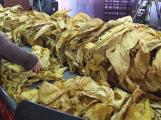27
Stripping TobaccoSeptember 2008
Bothwell, Ontario, Canada
 Credits:
Credits:Courtesy of Bothwell-Zone & District Historical Society
28
Strip Room:A portion of the pack barn was enclosed for the purpose of grading the tobacco leaves. The term strip room came about from the earlier method of harvesting tobacco with the entire stock. The leaves were stripped from the stocks before grading. Burley and black tobacco are still graded using this method. The expression strip room is still employed for flue-cured tobacco.
30
Hands:Tobacco leaves were gathered in bunches of six to eight leaves with a leaf wrapped around the end of the stems and tuck into the leaves to keep the hands tied firm. This was a very time consuming method of baling which soon was abandon for loose leaf baling.
31
The Ontario Flue-Cured Tobacco Growers' Marketing Board:A need to regulate the amount of tobacco grown each year and a controlled method of marketing tobacco which would be fair to both the grower and the buyer helped established the marketing board from 1958 to 2008. Other marketing associations had been formed from 1933 to 1957. The Board's role in 2009 is to issue licenses to growers who have signed contracts with cigarette companies making sure farmers do not exceed the allowed amount and will no longer be involved in selling tobacco.
33
The Dutch Auction Clock System:The electronic Dutch auction clock for selling tobacco uses a regressive rather than a progressive method of selling. As the hands progress down in price, the buyer pushes a button to stops the clock when it reaches the price for the tobacco which is listed for sale. The clock can not be stopped by two buyers at one time. The auction system of anonymous selling started when The Ontario Flue-Cured Tobacco Growers' Marketing Board formed in 1957 replacing the former contact system.

